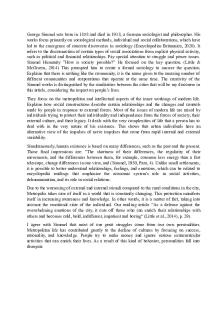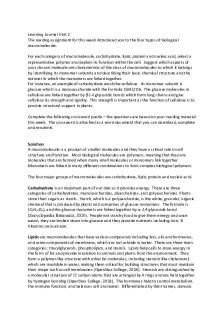Learning journal unit 3 PDF

| Title | Learning journal unit 3 |
|---|---|
| Author | Liz Be |
| Course | Macroeconomics |
| Institution | University of the People |
| Pages | 2 |
| File Size | 74.2 KB |
| File Type | |
| Total Downloads | 81 |
| Total Views | 152 |
Summary
Download Learning journal unit 3 PDF
Description
Learning journal unit 3 Reflect on the major topics of this unit and answer any three of the problems at the end of chapter seven in the text book. Be sure to consider alternative perspectives as you answer the problems. I choose the following questions from chapter 7 5. Give three reasons for the downward slope of the aggregate demand curve. The aggregate demand curve is a representation of aggregate demand (Rittenberg. L & Tregarthen. T, 2012). The aggregate demand curve shows downward sloping because of the following reasons (a) Change in net export – If there is a lower price level in Kenya, Kenyan goods will become relatively more competitive, leading to higher exports. Lower price level in an economy reduces the prices of its goods and services relative to foreign-produced goods and services. A lower price level makes that economy’s goods more attractive to foreign buyers, increasing exports. It will also make foreign-produced goods and services less attractive to the economy’s buyers, reducing imports. The result is an increase in net exports. (b) Lower interest rate – At a lower price, interest rates usually fall and this causes higher aggregate demand. A lower price level lowers the demand for money, because less money is required to buy a given quantity of goods. Thus, when the price level is low it reduces interest rates which make borrowing by firms to build factories or buying equipment and other capital more attractive. (c) Increased spending power. When the price level falls, consumers are likely to have higher disposable income and therefore spend more. For example, if the price level falls by 25%, then $10,000 of wealth could purchase more goods and services than it would have if the price level had not fallen. An increase in wealth will induce people to increase their consumption. The consumption component of aggregate demand will thus be greater at lower price levels than at higher price levels (Rittenberg. L & Tregarthen. T, 2012). 2. Explain why a change in one component of aggregate demand will cause the aggregate demand curve to shift by a multiple of the initial change. The aggregate demand curve is the total quantity of all goods and services demanded by the economy at different price levels. The AD like the demand curves for individual goods is downward sloping, implying that there is an inverse relationship between the price level and the quantity demanded of the real GDP. The shift of the AD means that at the same price levels and the quantity demanded of real GDP has decreased. Changes in the AD are caused by the changes in the demand for any of the components of real GDP, changes in demand for consumption
goods and services, changes in investment spending, changes in the government demand for goods and services and changes in the demand for net exports. If the consumers were to decrease their spending on all goods and services may be as a result of recession AD would shift to the left. 6. “When the price level falls, people’s wealth increases. When wealth increases, the real volume of consumption increases. Therefore, a decrease in the price level will cause the aggregate demand curve to shift to the right?” Do you agree with this statement? Explain. I think that, when wealth increases, consumers are likely to spend more money they have. The more they are likely to spend shifts the aggregate demand curve to the right. I agree with the statement. An increase in the price level leads to a decrease the purchasing power of the currency. This will decrease the desired consumption and therefore aggregate demand will shift to the left. Reference Rittenberg. L & Tregarthen. T, 2012). Macroeconomics Principles v.2.0 textbook. Retrieved fromhttps://my.uopeople.edu/pluginfile.php/136135/mod_resource/content/1/TEXT %20macroeconomics-principles-v2.0.pdf Tejvan Pettinger. (2017). Why is the Aggregate Demand (AD) curve downward sloping? Retrieved from https://www.economicshelp.org/blog/11437/economics/why-is-the-aggregatedemand-ad-curve-downward-sloping/...
Similar Free PDFs

Learning Journal Unit 3
- 2 Pages

Learning journal unit 3
- 2 Pages

UNIT 3 Learning Journal
- 2 Pages

LJ3 learning journal unit 3
- 2 Pages

Learning journal unit 4
- 3 Pages

Learning Journal Unit 1
- 2 Pages

Learning Journal Unit 8
- 2 Pages

Learning Journal unit 7
- 2 Pages

Learning Journal Unit 8
- 2 Pages

Learning Journal Unit 6
- 1 Pages

Learning Journal Unit 2
- 2 Pages

Learning Journal. Unit 6
- 3 Pages

Learning Journal Unit 2
- 2 Pages

Learning Journal Unit 4
- 2 Pages
Popular Institutions
- Tinajero National High School - Annex
- Politeknik Caltex Riau
- Yokohama City University
- SGT University
- University of Al-Qadisiyah
- Divine Word College of Vigan
- Techniek College Rotterdam
- Universidade de Santiago
- Universiti Teknologi MARA Cawangan Johor Kampus Pasir Gudang
- Poltekkes Kemenkes Yogyakarta
- Baguio City National High School
- Colegio san marcos
- preparatoria uno
- Centro de Bachillerato Tecnológico Industrial y de Servicios No. 107
- Dalian Maritime University
- Quang Trung Secondary School
- Colegio Tecnológico en Informática
- Corporación Regional de Educación Superior
- Grupo CEDVA
- Dar Al Uloom University
- Centro de Estudios Preuniversitarios de la Universidad Nacional de Ingeniería
- 上智大学
- Aakash International School, Nuna Majara
- San Felipe Neri Catholic School
- Kang Chiao International School - New Taipei City
- Misamis Occidental National High School
- Institución Educativa Escuela Normal Juan Ladrilleros
- Kolehiyo ng Pantukan
- Batanes State College
- Instituto Continental
- Sekolah Menengah Kejuruan Kesehatan Kaltara (Tarakan)
- Colegio de La Inmaculada Concepcion - Cebu

